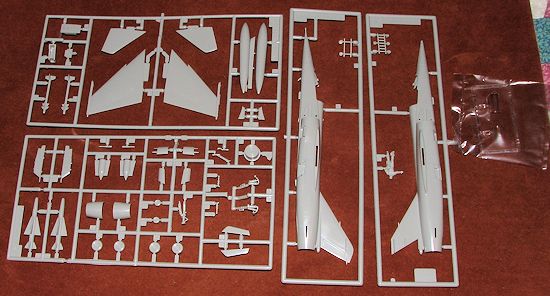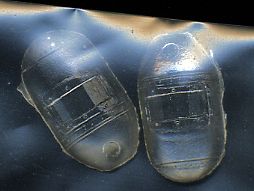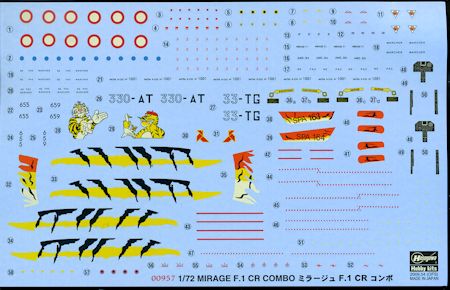
Hasegawa 1/72 Mirage F.1CR Combo
| KIT #: | 00957 |
| PRICE: | $29.11 on sale (@$58.00 SRP |
| DECALS: | Two options |
| REVIEWER: | Scott Van Aken |
| NOTES: | Two kits and resin. 2009 release |

| HISTORY |
The Dassault Mirage F-1 is a French air-superiority fighter and attack aircraft designed and built by Dassault Aviation as a successor of the Mirage III family. The Mirage F1 entered service in the French Air Force (Armée de l'Air) in the early seventies. Powered by a single SNECMA Atar turbojet providing about 7 tonnes-force (69 kN; 15,000 lbf) of thrust, the F1 has been used as a light multipurpose fighter and has been exported to about a dozen nations. More than 700 F1s have been produced.
When it became clear that the Mirage F1 was becoming a successful production aircraft, Dassault began investigating the possibility of a dedicated reconnaissance version for its most important client, the French Air Force. However, the escalating cost of fighter aircraft meant that add-on pods for this purpose were a more economical alternative.
Many French Air Force aircraft, as well as those of some export clients (such as Iraq's Mirage F1EQ), did indeed have a variety of reconnaissance pods available, which were attached to the underside of the main fuselage.
However, the development of a tactical reconnaissance aircraft for the French Air Force continued, and the first Mirage F1CR-200 flew on 20 November 1981.
The Mirage F1CR carries reconnaissance equipment, internally and externally:
A total of 64 Mirage F1CRs were ordered by the French Air Force. The first air force unit equipped with the CR was Escadron de Reconnaissance 2/33 which became operational in September 1983. Currently only 16 aircraft, comprising a single squadron, are still flying the Mirage F.1, soon to be replaced by the Rafale.
| THE KIT |
 This is what you would probably consider Hasegawa's second generation kit. It is before the overall engraved panel lines, but after the four foot thick plastic. This means that is has finely raised detailing with what engraved bits there are being a bit on the soft side. As it should as this kit has probably been pressed tens of thousands of times over the decades. Despite that, the molding is really quite well done with only a teeny bit of flash. Of course, this was a time when model companies did not sweat ejection pin marks so you find them on the insides of gear doors, on landing gear legs, weapons pylons and missiles. It was nice not to find these marks on the insides of wheels, which frequently occurs even on more modern Hasegawa kits.
This is what you would probably consider Hasegawa's second generation kit. It is before the overall engraved panel lines, but after the four foot thick plastic. This means that is has finely raised detailing with what engraved bits there are being a bit on the soft side. As it should as this kit has probably been pressed tens of thousands of times over the decades. Despite that, the molding is really quite well done with only a teeny bit of flash. Of course, this was a time when model companies did not sweat ejection pin marks so you find them on the insides of gear doors, on landing gear legs, weapons pylons and missiles. It was nice not to find these marks on the insides of wheels, which frequently occurs even on more modern Hasegawa kits.
The interior is really quite basic with little more than a tub, a seat shape, a control stick and instrument panel. It comes with a standing pilot so no filling the emptiness with a figure on this one. Decals for the instrument panel and side consoles, but Hasegawa does this even today. It does have a two piece windscreen/canopy so you can display the blandness of the interior. It also comes with a boarding ladder.
There are one piece wings with pylon holes already drilled as well as the usual two piece intakes that end in a blanking plate. Separate speed brakes with actuators are provided in case you want to display those extended. The one piece gear legs are a bit soft on detail compared to today's kits, but not bad. The main gear has separate retraction struts. Wheels are nicely done though a tad flashy so you'll need to clean that up.
The kit comes with an optional nose refueling probe and for things one and under the plane, there is a large centerline tanks, some Magic missiles for the wing tips and bigger missiles for the wing pylons. That explains the base kit, which is a Mirage F.1C.
 But this boxing is for a pair of the later Mirage F.1CRs. These planes have a recce camera in the nose and to duplicate this, a resin camera window piece is included (actually two as there are two kits). The builder also has a bit of a quandary. You see, the addendum sheet that comes with the kit has more than the instruction. It notes that you'll need to take the single large centerline tank and cut off the molded in pylon. Then you are to attach the standard wing pylon to this tank and put it under the wings. But wait, there is more. You only get one big tank per kit and you need two (one for each wing). Means one of your kits will have no large fuel tank. You also need to fill in the centerline tank holes now that you've used the tanks for the wings. Why Hasegawa did not provide the additional tanks is beyond me, but there it is. Perhaps aftermarket can help.
But this boxing is for a pair of the later Mirage F.1CRs. These planes have a recce camera in the nose and to duplicate this, a resin camera window piece is included (actually two as there are two kits). The builder also has a bit of a quandary. You see, the addendum sheet that comes with the kit has more than the instruction. It notes that you'll need to take the single large centerline tank and cut off the molded in pylon. Then you are to attach the standard wing pylon to this tank and put it under the wings. But wait, there is more. You only get one big tank per kit and you need two (one for each wing). Means one of your kits will have no large fuel tank. You also need to fill in the centerline tank holes now that you've used the tanks for the wings. Why Hasegawa did not provide the additional tanks is beyond me, but there it is. Perhaps aftermarket can help.
 Instructions are the old ones from the original boxing using Gunze paint references. This is also provided in the addendum sheet as wel as the precise placement of the camera mod and any mods needed for this version. Two very nice markings schemes come with the kit. One is the Tiger Meet markings for EC5/330, the test unit for the 2002 event. This is painted in the European Scheme. The other is a Desert scheme in four browns on a plane from ER 3/33. Both sides as well as upper and lower views are provided. The European scheme is very tight and it may be that masking will be the best way to duplicate this. The desert scheme plane has no date provided. Decals are nicely done and provide all the special markings needed. I should point out that on the Tiger Meet tanks, only the orange paint info is provided when you will definitely need a yellow as shown on the box art.
Instructions are the old ones from the original boxing using Gunze paint references. This is also provided in the addendum sheet as wel as the precise placement of the camera mod and any mods needed for this version. Two very nice markings schemes come with the kit. One is the Tiger Meet markings for EC5/330, the test unit for the 2002 event. This is painted in the European Scheme. The other is a Desert scheme in four browns on a plane from ER 3/33. Both sides as well as upper and lower views are provided. The European scheme is very tight and it may be that masking will be the best way to duplicate this. The desert scheme plane has no date provided. Decals are nicely done and provide all the special markings needed. I should point out that on the Tiger Meet tanks, only the orange paint info is provided when you will definitely need a yellow as shown on the box art.
| CONCLUSIONS |
This is a decidedly old kit and though I have not built one in all these years, I have built the ESCI version and the Heller kit. I fully expect this one to go together as well as their equally old Jaguar kit, especially when one considers the general dearth of parts compared to modern kits. One can, if the decals are available to one, do a standard F.1C, but not the F.1CT as the kit lacks the proper undernose sensor. I find it a shame that Hasegawa decided not to provide enough proper drop tanks, but hopefully the modeler can find spares from some other kit or aftermarket. Even on sale, the price of the kit may be more than some are willing to pay for a 30 year old mold, but the end result will be nice. At least get an aftermarket seat.
| REFERENCES |
http://en.wikipedia.org/wiki/Mirage_F1
April 2003
Thanks to me for the preview kit.
If you would like your product reviewed fairly and fairly quickly, please contactthe editor or see other details in the